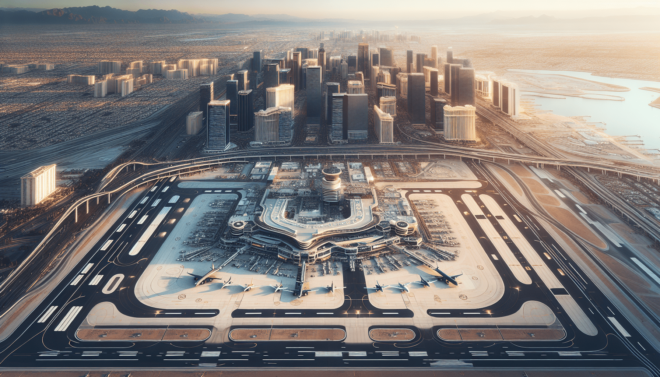Have you ever wondered why McCarran International Airport is a no-fly zone for drones? With the proliferation of drone technology, these devices have become pivotal for various uses, ranging from photography to infrastructure inspection. However, flying them comes with several restrictions, particularly around aviation facilities like McCarran International Airport.
Understanding McCarran International Airport
A Brief Overview of McCarran International Airport
McCarran International Airport (LAS) serves as the primary commercial airport for Las Vegas, Nevada. Situating near the dazzling lights of the Las Vegas Strip, the airport manages millions of passengers and numerous daily flights.
Importance of McCarran in Commercial Aviation
McCarran International Airport plays a critical role in commercial aviation, offering both domestic and international services. The airport not only serves passengers but also manages significant air cargo. Ensuring safety here is therefore paramount.
Drone Technology: A Brief Snapshot
Evolution and Uses of Drones
Drones, also known as Unmanned Aerial Vehicles (UAVs), have advanced considerably over the years. Originally developed for military purposes, they are now used in various civilian applications, including surveillance, disaster management, and even entertainment.
The Growing Popularity of Drones
With user-friendly interfaces and affordability, drones have seen a rapid rise in popularity. Hobbyists, professionals, and businesses all find diverse uses for these versatile gadgets.
Why No-fly Zones Exist
Ensuring Safety in the Skies
A significant reason for establishing no-fly zones is to ensure airspace safety. Air traffic control must maintain smooth operations without the interference of unauthorized drones.
Protecting Critical Infrastructure
Places like airports, military bases, and government buildings often enforce no-fly zones to protect critical infrastructure. Unauthorized drone flights in these areas can pose substantial risks.
Specific Reasons for McCarran’s No-fly Zone
Proximity to High Volume Air Traffic
McCarran International Airport deals with a high volume of air traffic, involving numerous arrivals and departures every day. Even a single drone can jeopardize the safe navigation of aircraft, posing risks to passengers and crew.
| Factors | Impact on Air Traffic |
|---|---|
| High Volume of Flights | Increased chances of collisions if drone enters airspace |
| Large Aircraft Movements | Greater risk due to the size and speed of commercial aircraft |
| Busy Airspace | Higher likelihood of mid-air conflicts |
Risk of Drone Collisions
Collisions between drones and aircraft can have devastating consequences. Even a small drone can severely damage an airplane’s engine, wings, or fuselage.
FAA Regulations
The Federal Aviation Administration (FAA) has strict regulations regarding drone operations near airports. These guidelines are intended to mitigate risks and maintain airspace safety.
Regulatory Framework Surrounding Drones
FAA Rules and Regulations
The FAA enforces various rules to regulate drone usage. These include altitude restrictions, no-fly zones, and mandatory registration for certain types of drones.
FAA’s Special No-fly Zones
Special no-fly zones are designated areas where drone operations are either restricted or completely banned. Airports, including McCarran International, fall under these zones due to their importance and high traffic.
| Regulation | Description |
|---|---|
| Altitude Restriction | Drones must not exceed 400 feet |
| No-fly Zones | Designated areas where drones can’t operate |
| Drone Registration | Mandatory registration for certain weight categories |
Techniques for Controlling Drones Near Airports
Geofencing Technology
Many modern drones come equipped with geofencing technology, a system that uses GPS to create virtual boundaries. When drones approach these ‘fences,’ they either alert the operator or automatically turn away.
Remote Identification
Remote identification requires drones to broadcast identifying information. This enables authorities to track and identify drones operating in restricted spaces.
Consequences of Violating No-fly Zones
Legal Implications
Violating no-fly zones can lead to hefty fines and other legal consequences. Drone operators found knowingly breaching these zones may face severe penalties.
| Violation Type | Possible Penalties |
|---|---|
| Unauthorized Flights | Fines up to several thousand dollars |
| Repeated Offenses | Increased penalties and possible jail terms |
Safety Risks Involved
The primary risk of violating a no-fly zone is compromising airspace safety. Unauthorized drones can cause mishaps, resulting in potential injuries or even fatalities.
The Role of Technology in Mitigating Risks
AI and Machine Learning
Artificial intelligence and machine learning algorithms can be integrated into air traffic management systems. These technologies can help detect unauthorized drones and alert authorities promptly.
Future of Drone Regulations
Continuous Evolution of Policies
As drone technology evolves, so do the regulations controlling it. Regulatory bodies like the FAA are continually updating policies to ensure they address the latest advancements and challenges in drone technology.
Community Awareness and Education
Educating the community about drone regulations and the importance of no-fly zones is crucial. Greater awareness can significantly reduce the number of violations and enhance overall airspace safety.
Summary
Understanding why McCarran International Airport is a no-fly zone for drones involves recognizing the complexities of air traffic management, the potential risks, and the stringent regulations in place to ensure safety. By respecting these guidelines and utilizing technology effectively, we can enjoy the benefits of drone technology without compromising airspace safety.
What You Can Do
Stay Updated with Regulations
Always stay updated with the latest FAA regulations to ensure your drone operations are within legal boundaries.
Educate Fellow Enthusiasts
Share this information with fellow drone enthusiasts to increase awareness and promote safer skies.
Utilize Technology
Make use of geofencing and other technological advancements to avoid inadvertently entering no-fly zones.
By adhering to these practices, you contribute to a safer and more regulated airspace, ensuring the harmony between recreational activities and commercial aviation continues unhampered.

